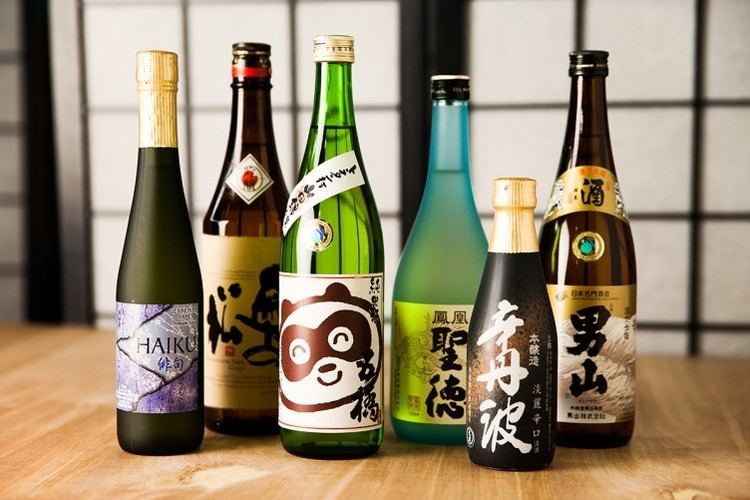 | ||
Similar Mirin, Rice, Sushi, Rice wine, Sashimi | ||
Japanese food sake letters from japan
Sake (Japanese: 酒), also spelled saké ( /ˈsɑːkeɪ/ SAH-kay or /ˈsɑːki/ SAH-kee) in English, is a Japanese rice wine made by fermenting rice that has been polished to remove the bran. Unlike wine, in which alcohol (ethanol) is produced by fermenting sugar that is naturally present in fruit, typically grapes; sake is produced by a brewing process more like that of beer, where the starch is converted into sugars before being converted to alcohol.
Contents
- Japanese food sake letters from japan
- Guide to japanese sake drinking all you need to know about sake
- History
- Rice
- Water
- Brewing
- Maturation
- Tji
- Special designation sake
- Ways to make the starter mash
- Different handling after fermentation
- Others
- Taste and flavor
- Serving sake
- Seasonality
- Storage
- Ceremonial use
- References

The brewing process for sake differs from the process for beer in that, for beer, the conversion from starch to sugar and from sugar to alcohol occurs in two distinct steps. Like other rice wines, when sake is brewed, these conversions occur simultaneously. Furthermore, the alcohol content differs between sake, wine, and beer. Wine generally contains 9%–16% ABV, while most beer contains 3%–9%, and undiluted sake contains 18%–20% (although this is often lowered to about 15% by diluting with water prior to bottling).
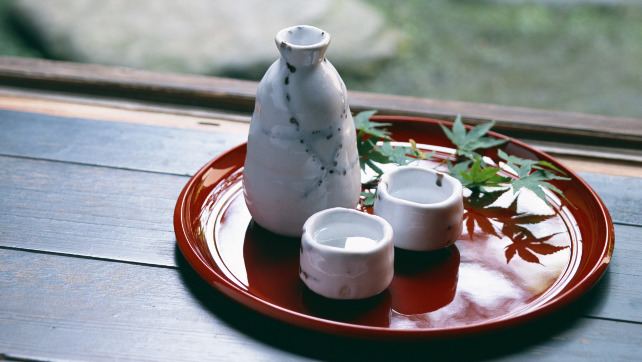
In the Japanese language, the word "sake" (酒, "liquor", also pronounced shu) can refer to any alcoholic drink, while the beverage called "sake" in English is usually termed nihonshu (日本酒, "Japanese liquor"). Under Japanese liquor laws, sake is labelled with the word seishu (清酒, "clear liquor"), a synonym less commonly used in conversation.
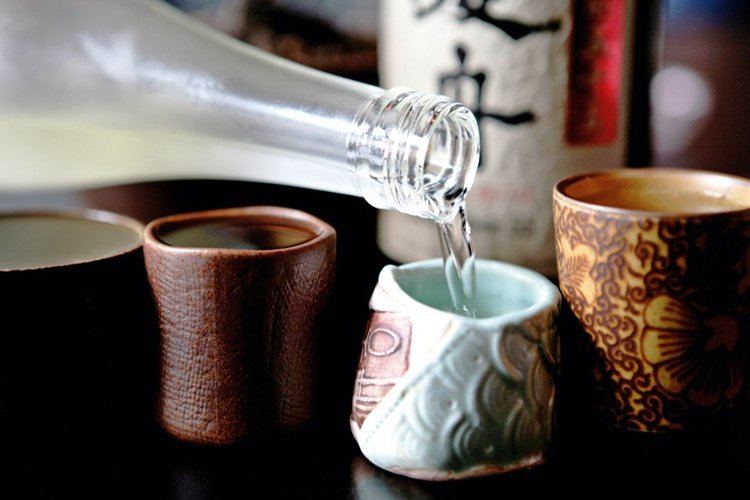
In Japan, where it is the national beverage, sake is often served with special ceremony – gently warmed in a small earthenware or porcelain bottle called a tokkuri, and sipped from a small porcelain cup called a sakazuki.
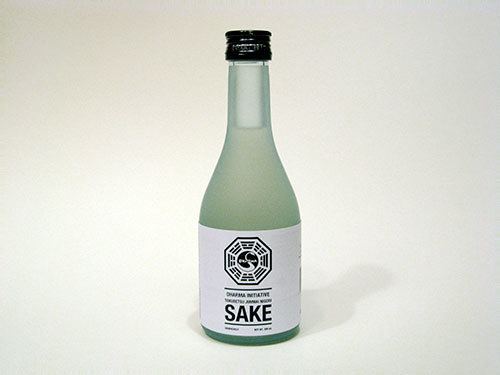
Guide to japanese sake drinking all you need to know about sake
History

The origin of sake is unclear. The making of Chinese alcoholic beverages predates recorded history. In the Yellow River area, bronze vessels for heating and serving alcoholic beverages survive from the later Shang dynasty, whose oracle bones contained the first surviving Chinese characters, including the word for alcoholic beverages: 酒 (pronunciation in pinyin: jiǔ).
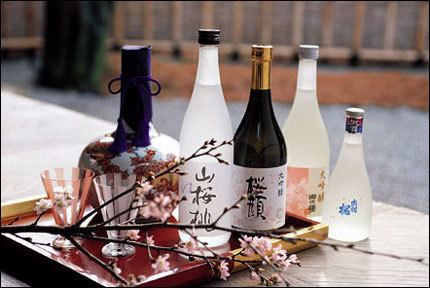
The earliest reference to the use of alcohol in Japan is recorded in the Book of Wei in the Records of the Three Kingdoms. This 3rd-century Chinese text speaks of the Japanese drinking and dancing. Alcoholic beverages (Japanese: 酒) are mentioned several times in the Kojiki, Japan's first written history, which was compiled in 712. Bamforth (2005) places the probable origin of true sake (which is made from rice, water, and kōji mold (麹, Aspergillus oryzae) in the Nara period (710–794). In the Heian period, sake was used for religious ceremonies, court festivals, and drinking games. Sake production was a government monopoly for a long time, but in the 10th century, temples and shrines began to brew sake, and they became the main centers of production for the next 500 years. The Tamon-in Diary, written by abbots of Tamon-in (temple) from 1478 to 1618, records many details of brewing in the temple. The diary shows that pasteurization and the process of adding ingredients to the main fermentation mash in three stages were established practices by that time. In the 16th century, the technique of distillation was introduced into the Kyushu district from Ryukyu. The brewing of shōchū, called "Imo—sake" started, and was sold at the central market in Kyoto.
In the 18th century, Engelbert Kaempfer and Isaac Titsingh published accounts identifying sake as a popular alcoholic beverage in Japan; but Titsingh was the first to try to explain and describe the process of sake brewing. The work of both writers was widely disseminated throughout Europe at the beginning of the 19th century.
During the Meiji Restoration, laws were written that allowed anybody with the money and know-how to construct and operate their own sake breweries. Around 30,000 breweries sprang up around the country within a year. However, as the years went by, the government levied more and more taxes on the sake industry and slowly the number of breweries dwindled to 8,000.
Most of the breweries that grew and survived this period were set up by wealthy landowners. Landowners who grew rice crops would have rice left over at the end of the season and, rather than letting these leftovers go to waste, would ship it to their breweries. The most successful of these family breweries still operate today.
During the 20th century, sake-brewing technology grew by leaps and bounds. The government opened the sake-brewing research institute in 1904, and in 1907 the very first government-run sake-tasting competition was held. Yeast strains specifically selected for their brewing properties were isolated and enamel-coated steel tanks arrived. The government started hailing the use of enamel tanks as easy to clean, lasting forever, and being devoid of bacterial problems. (The government considered wooden barrels to be unhygienic because of the potential bacteria living in the wood.) Although these things are true, the government also wanted more tax money from breweries, as using wooden barrels means that a significant amount of sake is lost to evaporation (somewhere around 3%), which could have otherwise been taxed. This was the end of the wooden-barrel age of sake and the use of wooden barrels in brewing was completely eliminated.
In Japan, sake has long been taxed by the national government. In 1898, this tax brought in about ¥5 million out of a total of about ¥120 million, about 46% of the government's total direct tax income.
During the Russo-Japanese War in 1904–1905, the government banned the home brewing of sake. At the time, sake still made up an astonishing 30% of Japan's tax revenue. Since home-brewed sake is tax-free sake, the logic was that by banning the home brewing of sake, sales would go up, and more tax money would be collected. This was the end of home-brewed sake, and the law remains in effect today even though sake sales now make up only 2% of government income.
When World War II brought rice shortages, the sake-brewing industry was dealt a hefty blow as the government clamped down on the use of rice for brewing. As early as the late 17th century, it had been discovered that small amounts of alcohol could be added to sake before pressing to extract aromas and flavors from the rice solids, but during the war, pure alcohol and glucose were added to small quantities of rice mash, increasing the yield by as much as four times. 75% of today's sake is made using this technique, left over from the war years. There were even a few breweries producing "sake" that contained no rice at all. Naturally, the quality of sake during this time varied greatly.
After the war, breweries slowly began to recover, and the quality of sake gradually went up. However, new players on the scene—beer, wine, and spirits—became very popular in Japan, and in the 1960s beer consumption surpassed sake for the first time. Sake consumption continued to go down while, in contrast, the quality of sake steadily improved.
Today, sake has become a world beverage with a few breweries springing up in China, Southeast Asia, South America, North America, and Australia. More breweries are also turning to older methods of production.
While the rest of the world may be drinking more sake and the quality of sake has been increasing, sake production in Japan has been declining since the mid-1970s. The number of sake breweries is also declining. While there were 3,229 breweries nationwide in fiscal 1975, the number had fallen to 1,845 in 2007.
October 1 is the official Sake Day (日本酒の日, "Nihonshu no Hi") of Japan.
Rice
The rice used for brewing sake is called saka mai 酒米 (sake rice), or officially shuzō kōtekimai 酒造好適米 (sake-brewing suitable rice). The grain is larger, stronger, and contains less protein and lipid than the ordinary rice eaten by the Japanese. The rice has a starch component called shinpaku (心白) in the center of the grains. Since sake made from rice containing only starch has a more commonly desired taste, the rice is polished to remove the bran. If a grain is small or weak, it will break in the process of polishing. Sake rice is used only for making sake, because it is unpalatable for eating. There are at least 80 types of sake rice in Japan. Among these, Yamadanishiki, Gohyakumangoku, Miyamanishiki and Omachi rice are very popular.
Water
Water is one of the important ingredients for making sake. It is involved in almost every major process of sake brewing from washing the rice to dilution of the final product before bottling. The mineral content of the water can play a large role in the final product. Iron will bond with an amino acid produced by the koji to produce off flavors and a yellowish color. Manganese, when exposed to ultraviolet light, will also contribute to discoloration. Conversely potassium, magnesium, and phosphoric acid serve as nutrients for yeast during fermentation and are considered desirable. The yeast will use those nutrients to work faster and multiply resulting in more sugar being converted into alcohol. While soft water will typically yield sweeter sake, hard water with a higher nutrient content is known for producing drier-style sake.
The first region known for having great water was the Nada-Gogō in Hyogo Prefecture. A particular water source called "Miyamizu" was found to produce high quality sake and attract many producers to the region. To this day Hyogo has the most sake brewers of any prefecture.
Typically breweries source their water from wells, though lakes and rivers can be used as well. Also breweries may use tap water and filter and adjust components as they see fit.
Brewing
Sake is produced by the multiple parallel fermentation of rice. The rice is first polished to remove the protein and oils from the exterior of the rice grains, leaving behind starch. Thorough milling leads to fewer congeners and generally a more desirable product.
Newly polished rice is allowed to "rest" until it has absorbed enough moisture from the air so that it will not crack when immersed in water. After this resting period, the rice is washed clean of the rice powder produced during milling and then steeped in water. The length of time depends on the degree to which the rice was polished, ranging from several hours or even overnight for an ordinary milling to just minutes for highly polished rice.
After soaking, the rice is steamed on a conveyor belt. The degree of cooking must be carefully controlled; overcooked rice will ferment too quickly for flavors to develop well, and undercooked rice will ferment only on the outside. The steamed rice is then cooled and divided into portions for different uses.
The microorganism Aspergillus oryzae (a mold) is sprinkled onto the steamed rice and allowed to ferment for 5–7 days (Uno et al., 2009). After this initial fermentation period, water and the yeast culture Saccharomyces cerevisiae are added to the koji (rice and mold mixture) and allowed to incubate at 4 °C (39 °F) for about 7 days. Over the next four days, pre-incubated mixture of steamed rice (90 kg [200 lb]), fermented rice (90 kg) and water (440 l [120 US gal]) are added to the fermented mixture in three series.
This staggered approach allows time for the yeast to keep up with the increased volume. The mixture is now known as the main mash, or moromi (醪, also written 諸味).
The main mash then ferments, at approximately 15–20 °C (59–68 °F) for 2–3 weeks. With high-grade sake, fermentation is deliberately slowed by lowering the temperature to 10 °C (50 °F) or less.
Unlike malt for beer, rice for sake does not contain the amylase necessary for converting starch to sugar; it must undergo a process of multiple fermentation. The addition of A. oryzae provides the necessary amylases, glucoamylases, and proteases to hydrolyze the nutrients of the rice to support the growth of the yeast(S.cerevisiae). In sake production these two processes take place at the same time rather than in separate steps, so sake is said to be made by multiple parallel fermentation.
After fermentation, sake is extracted from the solid mixtures through a filtration process. For some types of sake, a small amount of distilled alcohol, called brewer's alcohol (醸造アルコール), is added before pressing in order to extract flavors and aromas that would otherwise remain behind in the solids. In cheap sake, a large amount of brewer’s alcohol might be added to increase the volume of sake produced. Next, the remaining lees (a fine sediment) are removed, and the sake is carbon filtered and pasteurized. The sake is allowed to rest and mature and then usually diluted with water to lower the alcohol content from around 20% to 15% or so before it is finally bottled.
Maturation
Like other brewed beverages, sake tends to benefit from a period of storage. Nine to twelve months are required for sake to mature. Maturation is caused by physical and chemical factors such as oxygen supply, the broad application of external heat, nitrogen oxides, aldehydes and amino acids, among other unknown factors.
Tōji
Tōji (杜氏) is the job title of the sake brewer, named after Du Kang. It is a highly respected job in the Japanese society, with tōji being regarded like musicians or painters. The title of tōji was historically passed on from father to son; today new tōji are either veteran brewery workers or are trained at universities. While modern breweries with refrigeration and cooling tanks operate year-round, most old-fashioned sake breweries are seasonal, operating only in the cool winter months. During the summer and fall most tōji work elsewhere, and are commonly found on farms, only periodically returning to the brewery to supervise storage conditions or bottling operations.
Special-designation sake
There are two basic types of sake: Futsū-shu (普通酒, ordinary sake) and Tokutei meishō-shu (特定名称酒, special-designation sake). Futsū-shu is the equivalent of table wine and accounts for the majority of sake produced. Tokutei meishō-shu refers to premium sakes distinguished by the degree to which the rice has been polished and the added percentage of brewer's alcohol or the absence of such additives. There are eight varieties of special-designation sake. The listing here has the highest quality at the top.
Ways to make the starter mash
Different handling after fermentation
Others
Some other terms commonly used in connection with sake:
Taste and flavor
The label on a bottle of sake gives a rough indication of its taste. Terms found on the label may include nihonshu-do (日本酒度), san-do (酸度), and aminosan-do (アミノ酸度).
Nihonshu-do (日本酒度) is calculated from the specific gravity of the sake and indicates the sugar and alcohol content of the sake on an arbitrary scale. Typical values are between −3 (sweet) and +10 (dry), equivalent to specific gravities ranging between 1.007 and 0.998.
San-do (酸度) indicates the concentration of acid, which is determined by titration with sodium hydroxide solution. This number is equal to the milliliters of titrant required to neutralize the acid in 10 ml (0.35 imp fl oz; 0.34 US fl oz) of sake.
Aminosan-do (アミノ酸度) indicates a taste of umami or savoriness. As the proportion of amino acids rises, the sake tastes more savory. This number is determined by titration of the sake with a mixture of sodium hydroxide solution and formaldehyde, and is equal to the milliliters of titrant required to neutralize the amino acids in 10 ml of sake.
Sake can have many flavor notes, such as fruits, flowers, herbs, and spices. Many sakes have notes of apple from ethyl caproate, and banana from isoamyl acetate, particularly ginjyoshu (吟醸酒).
Serving sake
In Japan, sake is served chilled (reishu 冷酒), at room temperature (jōon 常温 or hiya 冷や), or heated (atsukan 熱燗), depending on the preference of the drinker, the quality of the sake, and the season. Typically, hot sake is a winter drink, and high-grade sake is not drunk hot, because the flavors and aromas will be lost. This masking of flavor is the reason that low-quality and old sake is often served hot. There are gradations of temperature both for chilling and heating, about every 5 °C (9.0 °F), with hot sake generally served around 50 °C (122 °F), and chilled sake around 10 °C (50 °F), like white wine. Hot sake that has cooled (kanzamashi 燗冷まし) may be reheated.
Sake is traditionally drunk from small cups called choko or o-choko (お猪口) and poured into the choko from ceramic flasks called tokkuri. This is very common for hot sake, where the flask is heated in hot water and the small cups ensure that the sake does not get cold in the cup, but may also be used for chilled sake. Traditionally one does not pour one’s own drink, which is known as tejaku (手酌), but instead members of a party pour for each other, which is known as shaku (酌). This has relaxed in recent years, but is generally observed on more formal occasions, such as business meals, and is still often observed for the first drink.
Another traditional cup is the masu, a box usually made of hinoki or sugi, which was originally used for measuring rice. The masu holds exactly 180 ml (6.3 imp fl oz; 6.1 US fl oz), so the sake is served by filling the masu to the brim; this is done for chilled or room temperature sake. In some Japanese restaurants, as a show of generosity, the server may put a glass inside the masu or put the masu on a saucer and pour until sake overflows and fills both containers.
Saucer-like cups called sakazuki are also used, most commonly at weddings and other ceremonial occasions, such as the start of the year or at the beginning of a kaiseki meal. In cheap bars, sake is often served room temperature in glass tumblers and called koppu-zake (コップ酒). In more modern restaurants wine glasses are also used, and recently footed glasses made specifically for premium sake have also come into use.
Sake is traditionally served in units of 180 ml (6.3 imp fl oz; 6.1 US fl oz) (one gō), and this is still common, but other sizes are sometimes also available.
Traditionally sake is heated immediately before serving, but today restaurants may buy sake in boxes which can be heated in a specialized hot sake dispenser, thus allowing hot sake to be served immediately, though this is detrimental to the flavor. There are also a variety of devices for heating sake and keeping it warm, beyond the traditional tokkuri.
Aside from being served straight, sake can be used as a mixer for cocktails, such as tamagozake, saketinis or nogasake. Another common method for serving sake is in a sake bomb. While the origins of this drink are unclear, it has become a popular drink in bars and karoke clubs around the world.
Seasonality
Traditionally sake was brewed only in the winter. While it can now be brewed year-round, there is still seasonality associated with sake, particularly artisanal ones. The most visible symbol of this is the sugitama (杉玉), a globe of cedar leaves traditionally hung outside a brewery when the new sake is brewed. The leaves start green, but turn brown over time, reflecting the maturation of the sake. These are now hung outside many restaurants serving sake. The new year's sake is called shinshu 新酒 ("new sake"), and when initially released in late winter or early spring, many brewers have a celebration, known as kurabiraki 蔵開き (warehouse opening). Traditionally sake was best transported in the cool spring, to avoid spoilage in the summer heat, with a secondary transport in autumn, once the weather had cooled, known as hiyaoroshi 冷卸し ("cold wholesale distribution") – this autumn sake has matured over the summer.
There is not traditionally a notion of vintage of sake – it is generally drunk within the year, and if aged, it does not vary significantly from year to year. Today, with influence from wine vintages, some breweries label sake intended for aging with a vintage, but this is otherwise rare.
Storage
Sake is sold in volume units divisible by 180 ml (6.3 imp fl oz; 6.1 US fl oz) (a gō), the traditional Japanese unit for cup size: sake is traditionally sold by the gō-sized cup, or in a 1.8 l (63 imp fl oz; 61 US fl oz) (one shō, ten gō) sized flask. Today sake is also often sold in 720 ml (25 imp fl oz; 24 US fl oz) (four gō) bottles – note that this is almost the same as the 750 ml (26 imp fl oz; 25 US fl oz) standard for wine bottles, but is divisible into 4 gō. Particularly in convenience stores, sake may be sold in a 180 ml (6.3 imp fl oz; 6.1 US fl oz) single serving glass with a pull-off top (カップ酒 kappu-zake) – this is generally cheap sake – or in a small 360 ml (13 imp fl oz; 12 US fl oz) bottle.
In general, it is best to keep sake refrigerated in a cool or dark room, as prolonged exposure to heat or direct light will lead to spoilage. In addition, sake stored at relatively high temperature can lead to formation of dicetopiperazine, a cyclo (Pro-Leu) that makes it bitter as it ages (Lecture Note, Oct. 2011). Sake has high microbiological stability due to its high content of ethanol. However, incidences of spoilage have been known to occur. One of the microoganisms implicated in this spoilage is lactic acid bacteria (LAB) that has grown tolerant to ethanol and is referred to as hiochi-bacteria (Suzuki et al., 2008). Sake stored at room temperature is best consumed within a few months after purchase.
After opening a bottle of sake, it is best consumed within 2 or 3 hours. It is possible to store sake in the refrigerator, but it is recommended to finish the sake within 2 days. This is because once premium sake is opened it begins to oxidize, which affects the taste. If the sake is kept in the refrigerator for more than 3 days, it will lose its "best" flavor. However, this does not mean it should be disposed of if not consumed. Generally, sake can keep very well and still taste just fine after weeks in the refrigerator. How long a sake will remain drinkable depends on the actual product itself, and whether it is sealed with a wine vacuum top.
Ceremonial use
Sake is often consumed as part of Shinto purification rituals. Sakes served to gods as offerings prior to drinking are called o-miki or miki (お神酒, 神酒). People drink Omiki with gods to communicate with them and to solicit rich harvests the following year. During World War II, kamikaze pilots drank sake prior to carrying out their missions.
In a ceremony called kagami biraki, wooden casks of sake are opened with mallets during Shinto festivals, weddings, store openings, sports and election victories, and other celebrations. This sake, called iwai-zake ("celebration sake"), is served freely to all to spread good fortune.
At the New Year many Japanese people drink a special sake called toso. Toso is a sort of iwai-zake made by soaking tososan, a Chinese powdered medicine, overnight in sake. Even children sip a portion. In some regions, the first sips of toso are taken in order of age, from the youngest to the eldest.
